Forecasting the Number of Road Accidents in Poland by Road Type
1
Stanislaw Staszic State University of Applied Sciences in Pila, Podchorazych 10 Street, 64-920 Pila, Poland
2
Malaysian Institute of Road Safety Research, Lot 125-135, Jalan TKS1, Taman Kajang Sentral, 43000 Kajang, Selangor, Malaysia
*
For correspondence.
Academic Editor:
Received: 6 October 2023 Accepted: 9 February 2024 Published: 23 February 2024
Abstract
On Polish highways, a staggering number of individuals pass away each year. The quantity is still quite large even if the value is declining year after year. The value of traffic accidents has greatly decreased due to the epidemic, but it is still quite high. In order to reduce this number, it is required to identify the roads where the majority of accidents occur and to understand the predicted number of accidents in the upcoming years. The article’s goal is to predict how many accidents will occur on Polish roads based on the kind of roads. To achieve this, monthly accident data for Poland from the Police’s statistics for the years 2007–2021 were analyzed, and a prediction for the years 2022–2024 was created. As is evident, either the number of accidents is rising or it is stabilizing. This is mostly caused by the rise in automobile traffic. Additionally, predictions indicate that given the existing circumstances, a significant rise in the number of accidents on Polish roads may be anticipated. This is especially evident in the nation’s growing number of freeways. It should be remembered that the current epidemic distorts the findings. Selected time series models were used in the investigation in Statistica.
Figures in this Article
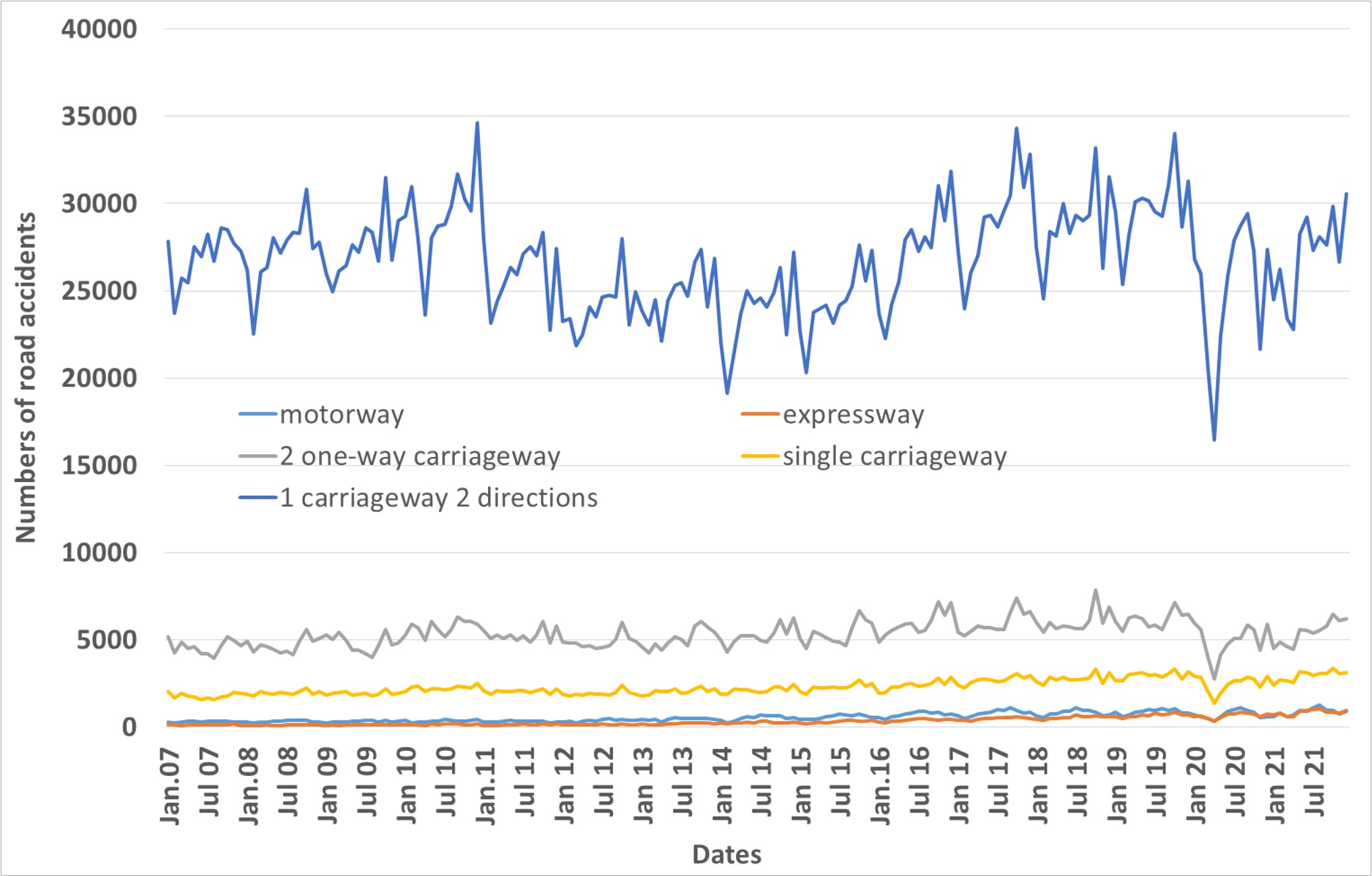 Figure 1
Figure 1
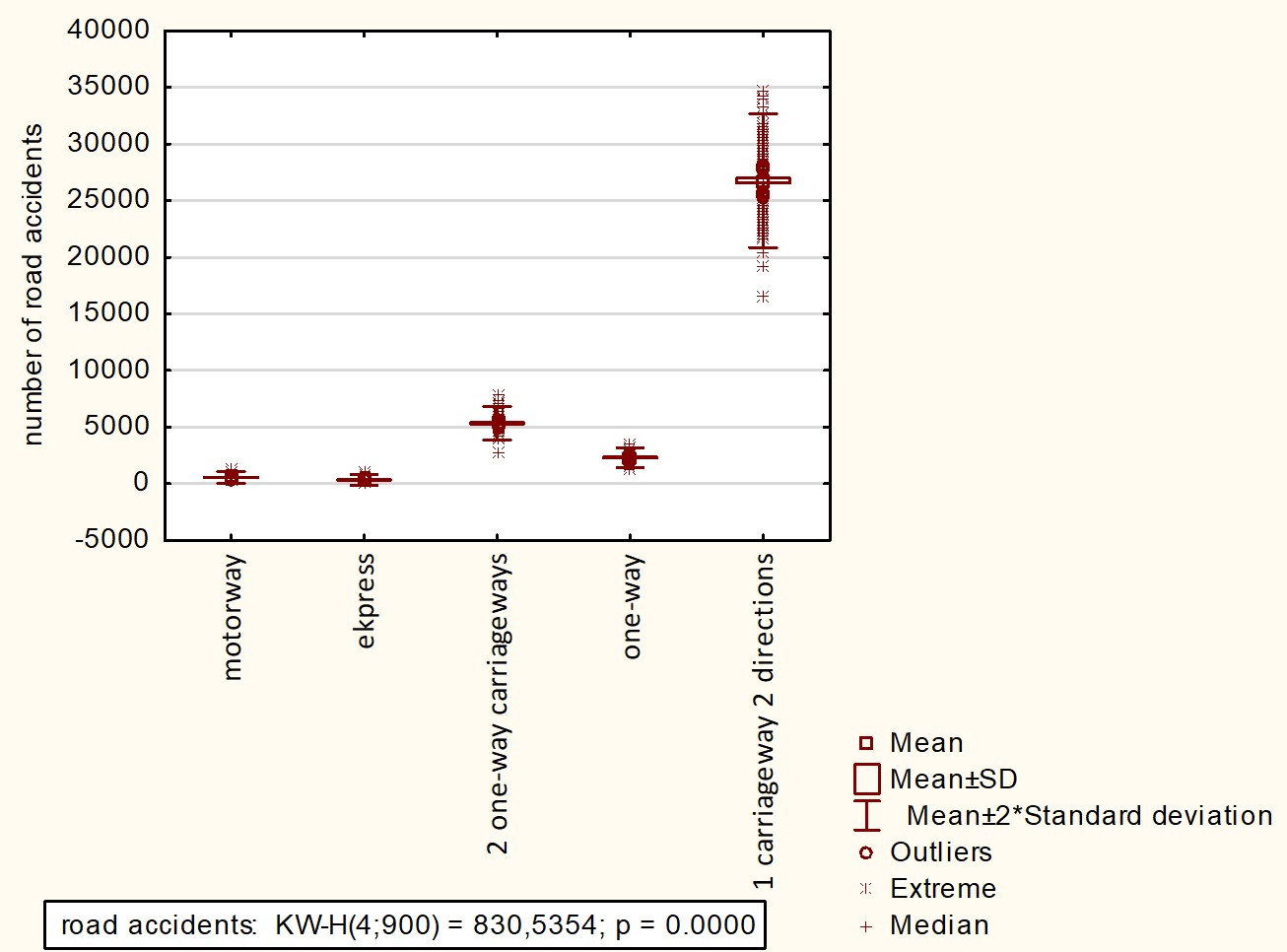 Figure 2
Figure 2
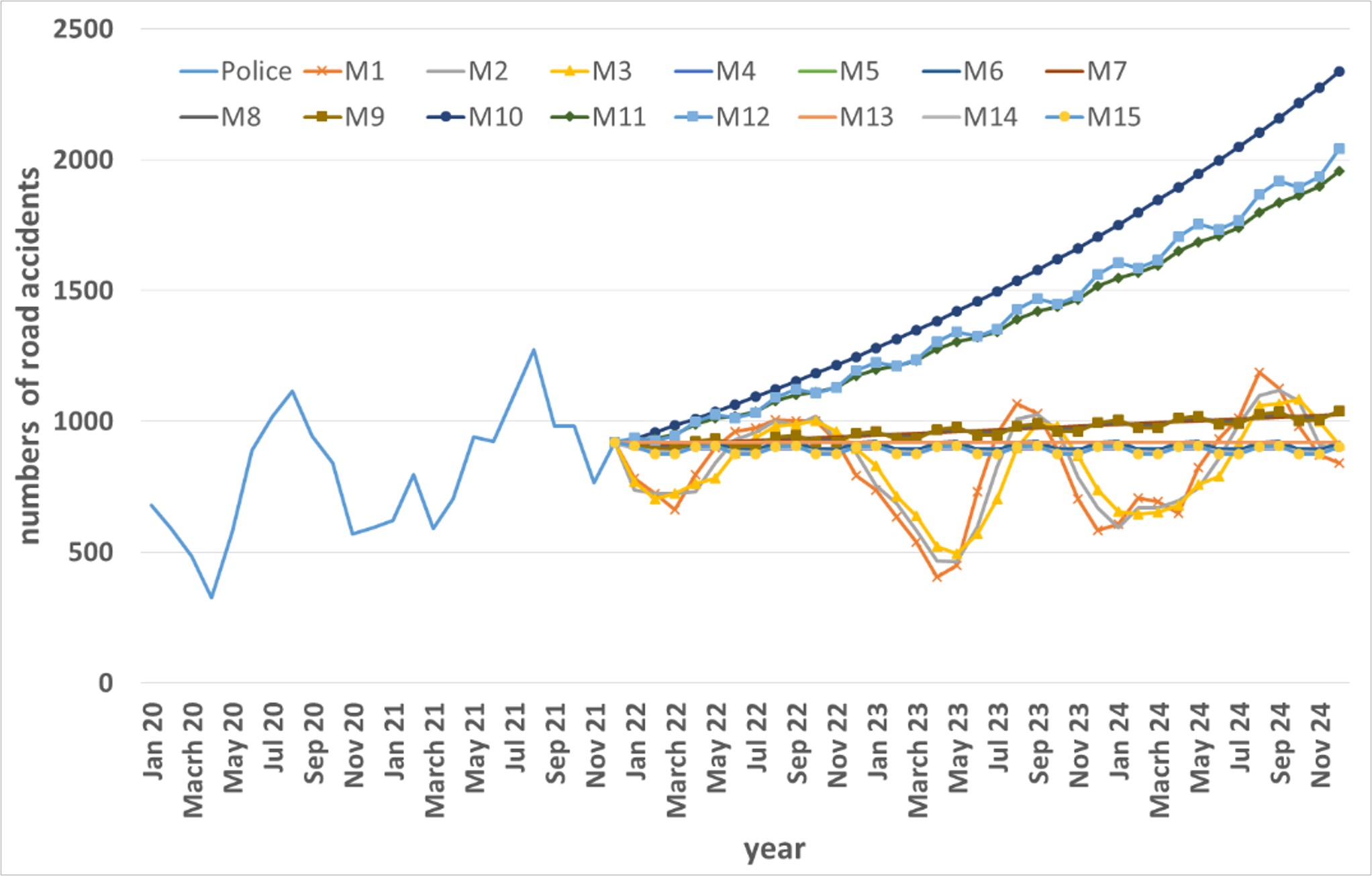 Figure 3
Figure 3
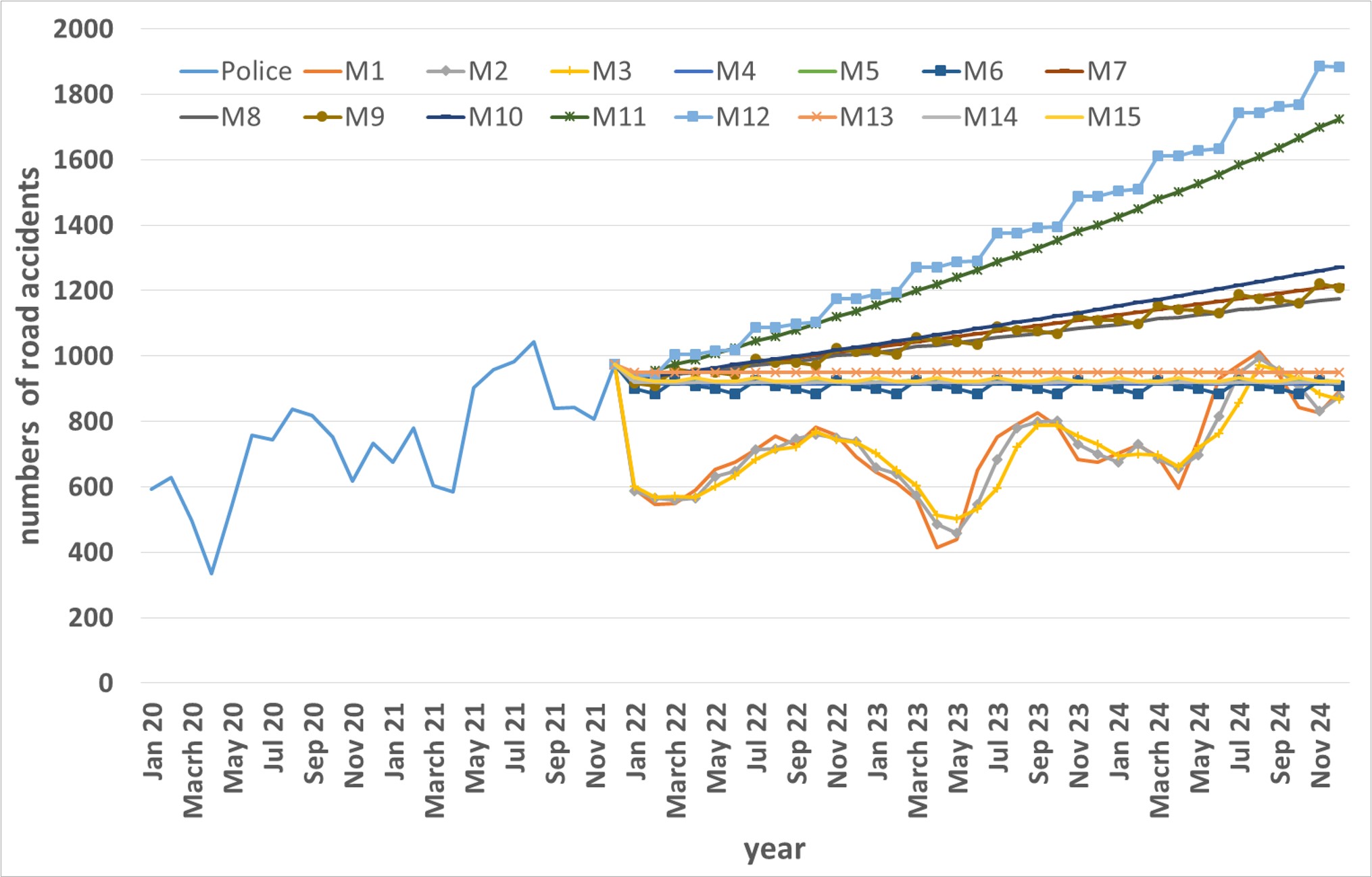 Figure 4
Figure 4
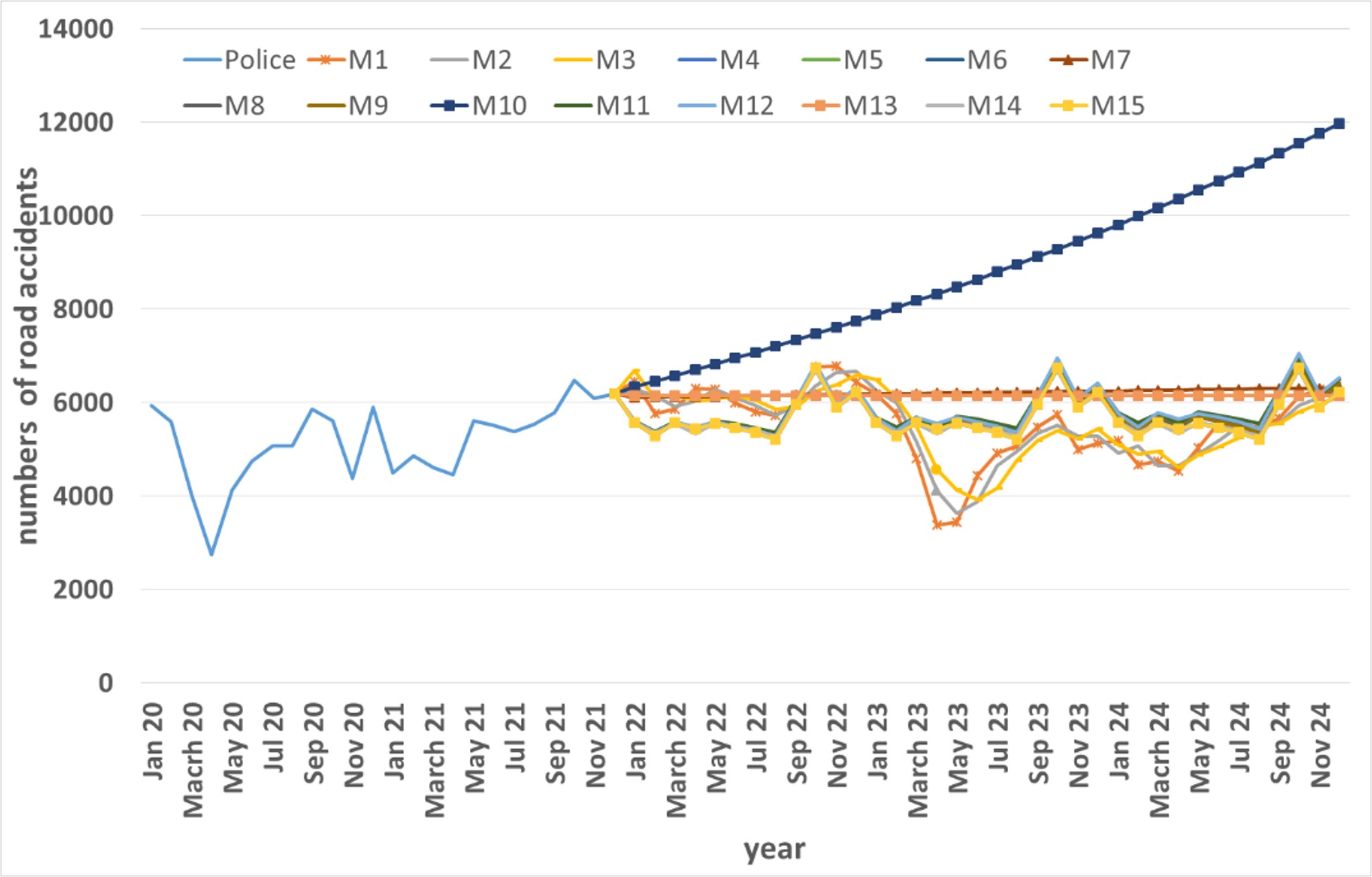 Figure 5
Figure 5
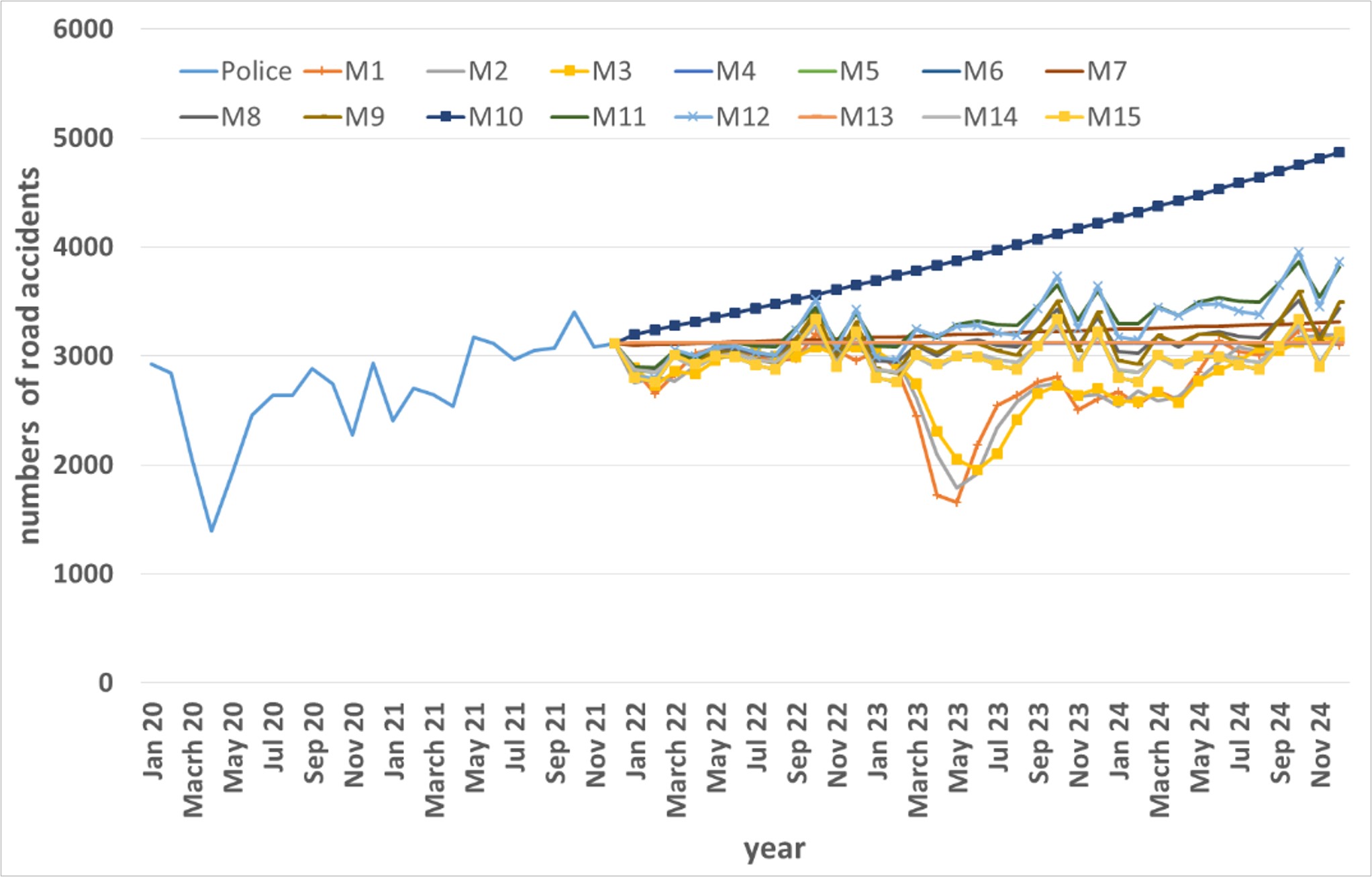 Figure 6
Figure 6
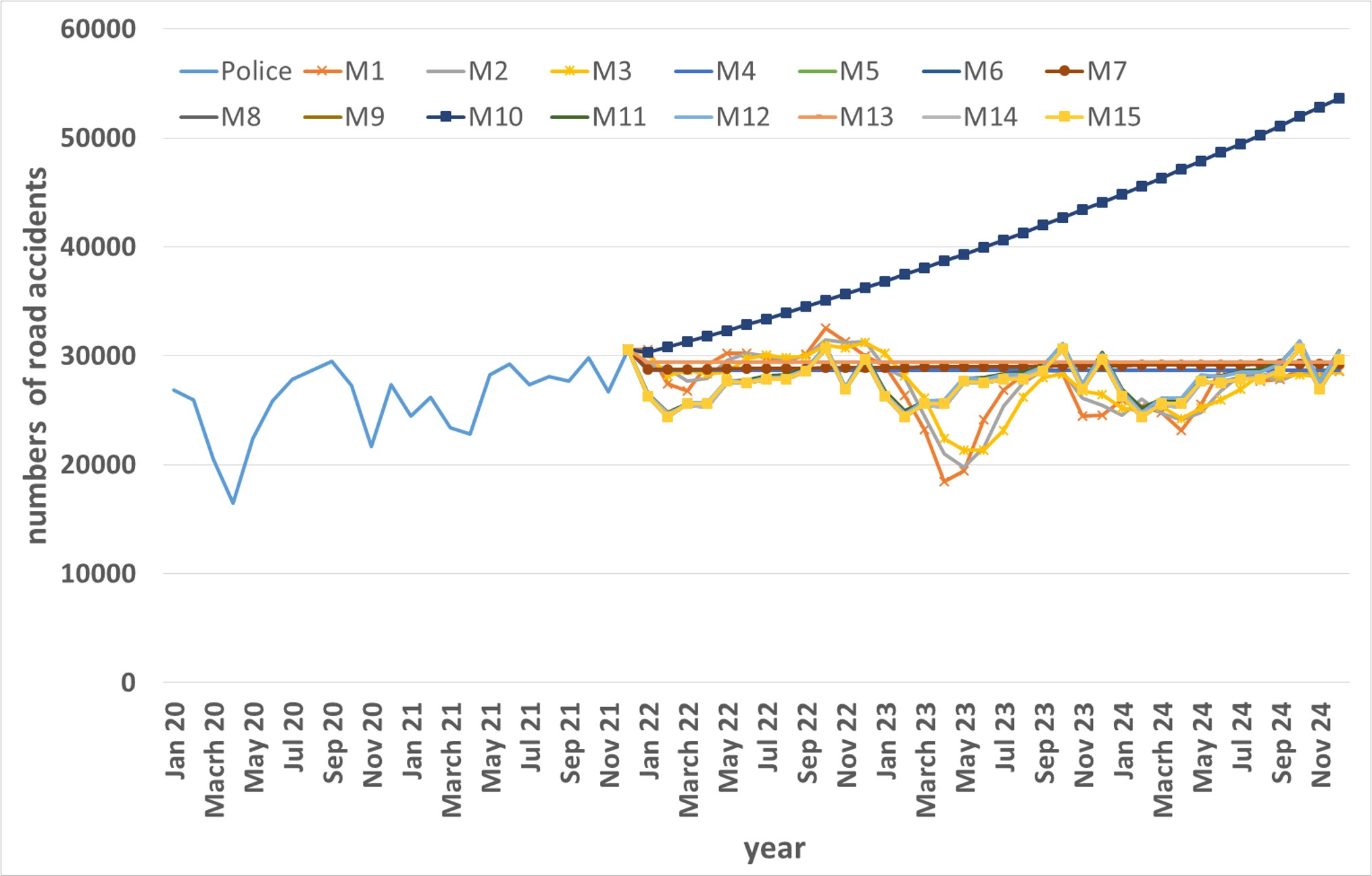 Figure 7
Figure 7
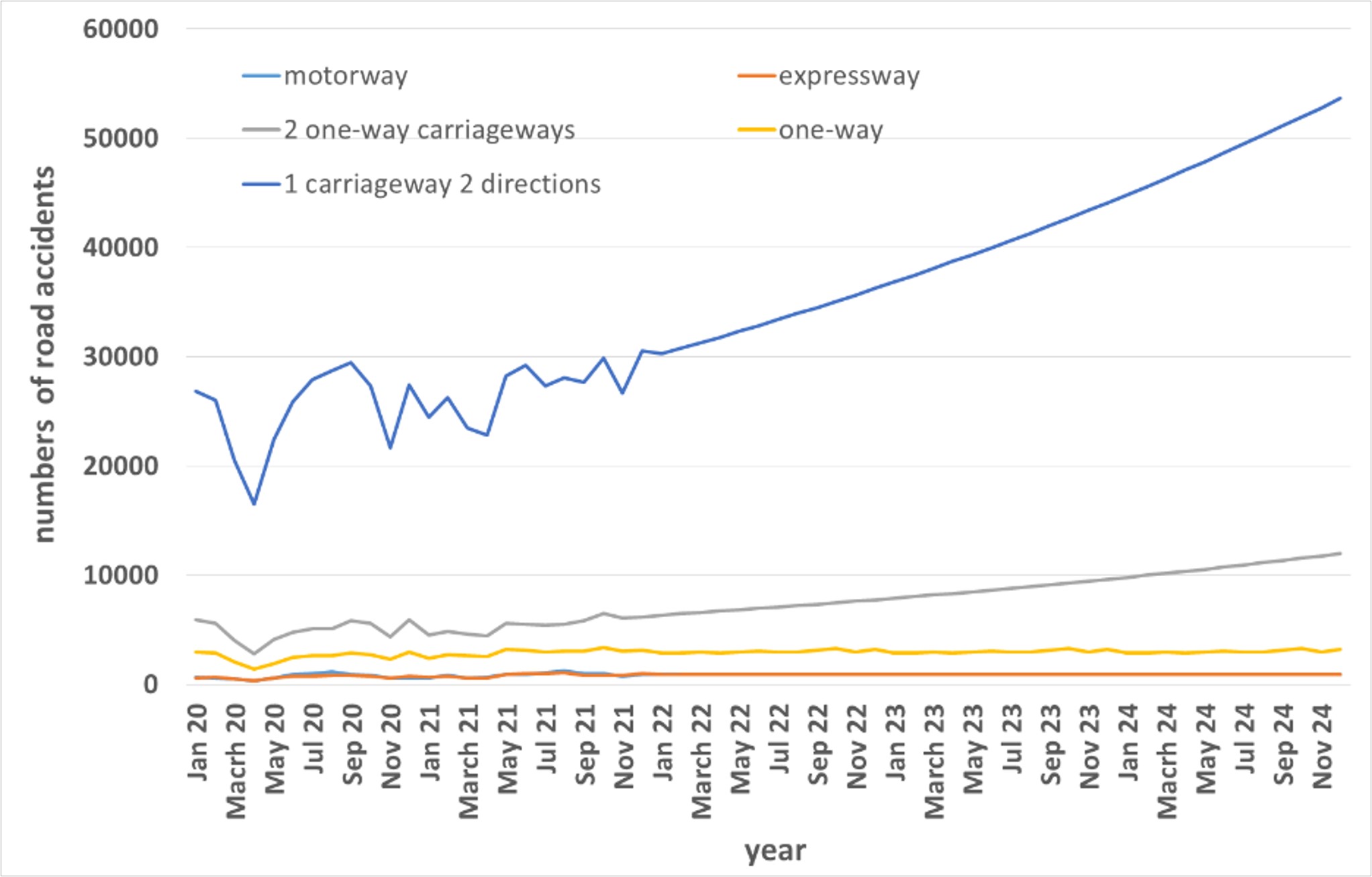 Figure 8
Figure 8
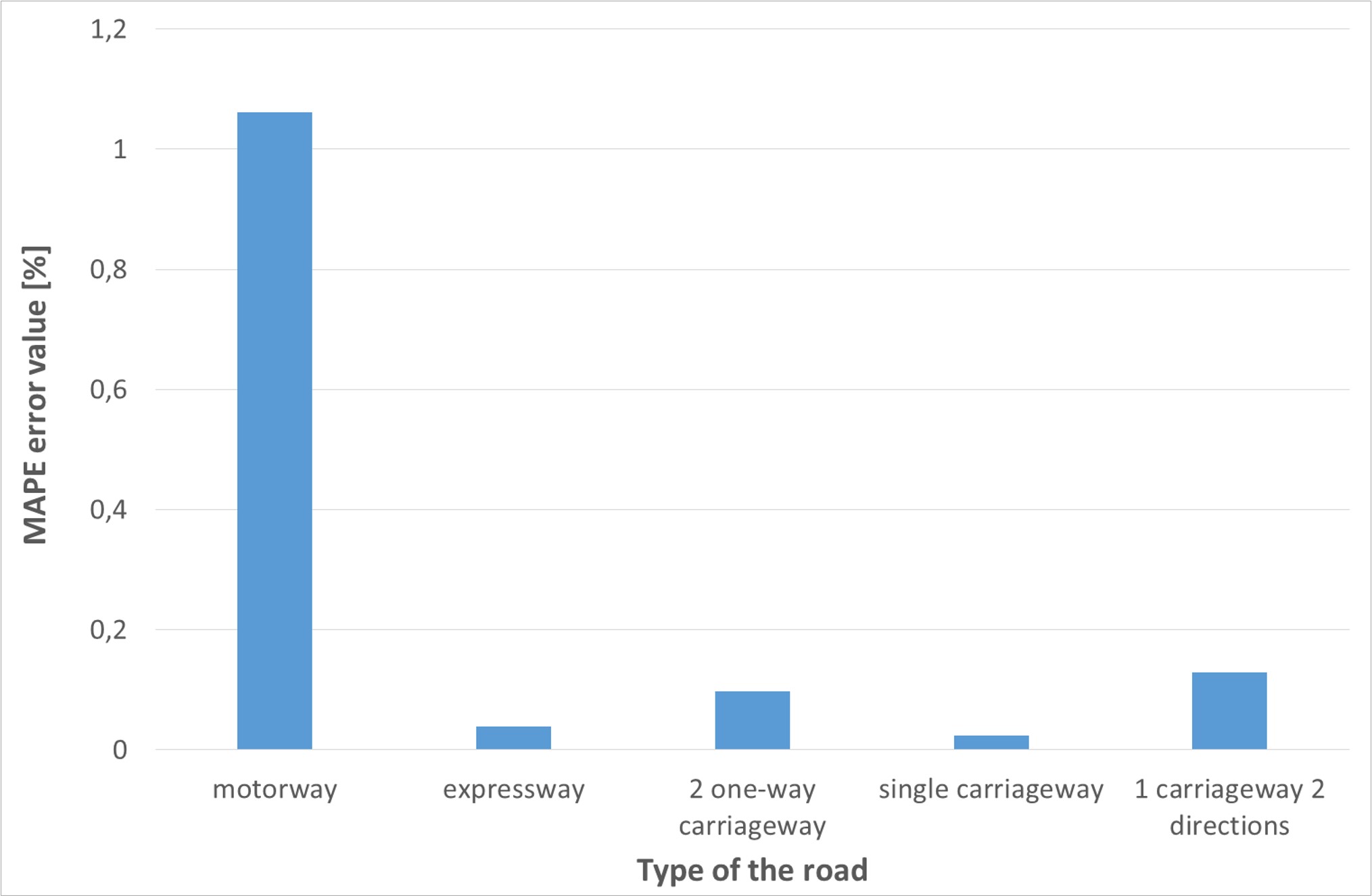 Figure 9
Figure 9
Keywords
Copyright © 2024
Gorzelańczyk and Ho. This article is distributed under the terms of the Creative Commons Attribution License (CC BY 4.0), which permits unrestricted use and distribution provided that the original work is properly cited.
Funding
This research received no specific grant from any funding agency in the public, commercial, or not-for-profit sectors.
Cite this Article
Gorzelańczyk, P., & Ho, J. S. (2024). Forecasting the Number of Road Accidents in Poland by Road Type. Highlights of Vehicles, 2(1), 13–23. https://doi.org/10.54175/hveh2010002
References
1.
World Health Organization (WHO). (Ed.). (2018). The Global status on road safety 2018. https://www.who.int/publications/i/item/9789241565684 (accessed 10 February 2022).
2.
Tambouratzis, T., Souliou, D., Chalikias, M., & Gregoriades, A. (2014). Maximising accuracy and efficiency of traffic accident prediction combining information mining with computational intelligence approaches and decision trees. Journal of Artificial Intelligence and Soft Computing Research, 4(1), 31–42. https://doi.org/10.2478/jaiscr-2014-0023
3.
Zhu, L., Lu, L., Zhang, W., Zhao, Y., & Song, M. (2019). Analysis of accident severity for curved roadways based on Bayesian networks. Sustainability, 11(8), 2223. https://doi.org/10.3390/su11082223
4.
Arteaga, C., Paz, A., & Park, J. (2020). Injury severity on traffic crashes: A text mining with an interpretable machine-learning approach. Safety Science, 132, 104988. https://doi.org/10.1016/j.ssci.2020.104988
5.
Yang, Z., Zhang, W., & Feng, J. (2022). Predicting multiple types of traffic accident severity with explanations: A multi-task deep learning framework. Safety Science, 146, 105522. https://doi.org/10.1016/j.ssci.2021.105522
6.
Gorzelanczyk, P., Pyszewska, D., Kalina, T., & Jurkovic, M. (2020). Analysis of road traffic safety in the Pila poviat. Scientific Journal of Silesian University of Technology. Series Transport, 107, 33–52. https://doi.org/10.20858/sjsutst.2020.107.3
7.
Chen, C. (2017). Analysis and forecast of traffic accident big data. ITM Web of Conferences, 12, 04029. https://doi.org/10.1051/itmconf/20171204029
8.
Khaliq, K. A., Chughtai, O., Shahwani, A., Qayyum, A., & Pannek, J. (2019). Road Accidents Detection, Data Collection and Data Analysis Using V2X Communication and Edge/Cloud Computing. Electronics, 8, 896. https://doi.org/10.3390/electronics8080896
9.
Rajput, H., Som, T., & Kar, S. (2015). An automated vehicle license plate recognition system. Computer, 48(8), 56–61. https://doi.org/10.1109/MC.2015.244
10.
Zheng, Z., Wang, C., Wang, P., Xiong, Y., Zhang, F., & Lv, Y. (2018). Framework for fusing traffic information from social and physical transportation data. PLOS ONE, 13(8), e0201531. https://doi.org/10.1371/journal.pone.0201531
11.
Abdullah, E., & Emam, A. (7–9 December 2015). Traffic accidents analyzer using big data. 2015 International Conference on Computational Science and Computational Intelligence (CSCI), Las Vegas, NV, USA. https://doi.org/10.1109/CSCI.2015.187
12.
Vilaça, M., Silva, N., & Coelho, M. C. (2017). Statistical analysis of the occurrence and severity of crashes involving vulnerable road users. Transportation Research Procedia, 27, 1113–1120. https://doi.org/10.1016/j.trpro.2017.12.113
13.
Bąk, I., Cheba, K., & Szczecińska, B. (2019). The statistical analysis of road traffic in cities of Poland. Transportation Research Procedia, 39, 14–23. https://doi.org/10.1016/j.trpro.2019.06.003
14.
Chand, A., Jayesh, S., & Bhasi, A. B. (2021). Road traffic accidents: An overview of data sources, analysis techniques and contributing factors. Materials Today: Proceedings, 47(15), 5135–5141. https://doi.org/10.1016/j.matpr.2021.05.415
15.
Helgason, A. F. (2016). Fractional integration methods and short Time series: evidence from a simulation study. Political Analysis, 24(1), 59–68.
16.
Lavrenz, S. M., Vlahogianni, E. I., Gkritza, K., & Ke, Y. (2018). Time series modeling in traffic safety research. Accident Analysis & Prevention, 117, 368–380. https://doi.org/10.1016/j.aap.2017.11.030
17.
Kowalski, L. (2022). Forecasting based on time series (in Polish). http://pis.rezolwenta.eu.org/Materialy/PiS-W-5.pdf (accessed 10 February 2022).
18.
Sunny, C. M., Nithya, S., Sinshi, K. S., Vinodini, V., Lakshmi, A., Anjana, S., et al. (7–9 August 2018). Forecasting of Road Accident in Kerala: A Case Study. 2018 International Conference on Data Science and Engineering (ICDSE), Kochi, India. https://doi.org/10.1109/ICDSE.2018.8527825
19.
Procházka, J., Flimmel, S., Čamaj, M., & Bašta, M. (30 August–3 September 2017). Modelling the Number of Road Accidents. 20-th AMSE. Applications of Mathematics and Statistics in Economics. International Scientific Conference, Szklarska Poręba, Poland. https://doi.org/10.15611/amse.2017.20.29
20.
Szmuksta-Zawadzka, M., & Zawadzki, J. (2009). Forecasting on the basis of Holt-Winters models for complete and incomplete data (in Polish). Ekonometria, 24(38), 85–99.
21.
Wójcik, A. (2014). Autoregressive vector models as a response to the critique of multi-equation structural econometric models. University of Economics in Katowice.
22.
Al-Madani, H. M. N. (2018). Global road fatality trends’ estimations based on country-wise microlevel data. Accident Analysis & Prevention, 111, 297–310. https://doi.org/10.1016/j.aap.2017.11.035
23.
Monederoa, B. D., Gil-Alanaa, L. A., & Martínezaa, M. C. V. (2021). Road accidents in Spain: Are they persistent? IATSS Research, 45(3), 317–325. https://doi.org/10.1016/j.iatssr.2021.01.002
24.
Mamczur, M. (31 August 2020). Machine learning How does linear regression work? And is it worth using? https://miroslawmamczur.pl/jak-dziala-regresja-liniowa-i-czy-warto-ja-stosowac (accessed 10 February 2022).
25.
Piłatowska, M. (2012). The choice of the order of autoregression depending on the parameters of the generating model (in Polish). Econometrics, 4(38), 16–35.
26.
Biswas, A. A., Mia, M. J., & Majumder, A. (6–8 July 2019). Forecasting the Number of Road Accidents and Casualties using Random Forest Regression in the Context of Bangladesh. 2019 10th International Conference on Computing, Communication and Networking Technologies (ICCCNT), Kanpur, India. https://doi.org/10.1109/ICCCNT45670.2019.8944500
27.
Wikipedia. (2022). Random forest. https://en.wikipedia.org/wiki/Random_forest (accessed 10 February 2022).
28.
Fijorek, K., Mróz, K., Niedziela, K., & Fijorek, D. (2010). Forecasting electricity prices on the day-ahead market using data mining methods (in Polish). Energy Market.
29.
Chudy-Laskowska, K., & Pisula, T. (2014). Forecast of the number of road accidents in Poland (in Polish). Logistics, 6, 2710–2722.
30.
Łobejko, S. (2015). Time series analysis and forecasting with SAS. Main business school in Warsaw.
31.
Prochazka, J., & Camaj, M. (2017). Modelling the number of road accidents of uninsured drivers and their severity. In Proceedings of International Academic Conferences 5408040, International Institute of Social and Economic Sciences.
32.
Dutta, B., Barman, M. P., & Patowary, A. N. (2020). Application of Arima model for forecasting road accident deaths in India. International Journal of Agricultural and Statistical Sciences, 16(2), 607–615.
33.
Karlaftis, M. G., & Vlahogianni, E. I. (2009). Memory properties and fractional integration in transportation time-series. Transportation Research Part C: Emerging Technologies, 17(4), 444–453. https://doi.org/10.1016/j.trc.2009.03.001
34.
Dudek, G. (2013). Forecasting Time Series with Multiple Seasonal Cycles Using Neural Networks with Local Learning. In L. Rutkowski, M. Korytkowski, R. Scherer, R. Tadeusiewicz, L. A. Zadeh, & J. M. Zurada (Eds.), Artificial Intelligence and Soft Computing. ICAISC 2013. Lecture Notes in Computer Science (Vol. 7894). Springer. https://doi.org/10.1007/978-3-642-38658-9_5
35.
Chudy-Laskowska, K., & Pisula, T. (2015). Forecasting the number of road accidents in Subcarpathia (in Polish). Logistics, 4, 2782–2796.
36.
Gregorczyk, A., & Swarcewicz, M. (2012). Analiza wariancji w układzie powtarzanych pomiarów do określenia efektów czynników wpływających na pozostałości linuronu w glebie (in Polish). Polish Journal of Agronomy, 11, 15–20.
37.
Wrobel, M. S. (2017). Application of neural fuzzy systems in chemistry [PhD Thesis]. University of Silesia in Katowice.
38.
StatSoft. (2022). Data Mining Techniques (in Polish). https://www.statsoft.pl/textbook/stathome_stat.html? https%3A%2F%2Fwww.statsoft.pl%2Ftextbook%2Fstdatmin.html (accessed 10 February 2022).
39.
Kumar, P. S., Viswanadham, V., & Bharathi, B. (2019). Analysis of road accident. IOP Conference Series Materials Science and Engineering, 590, 012029. https://doi.org/10.1088/1757-899X/590/1/012029
40.
DataFlair. (2022). Top Advantages and Disadvantages of Hadoop 3. https://data-flair.training/blogs/advantages-and-disadvantages-of-hadoop (accessed 10 February 2022).
41.
Perczak, G., & Fiszeder, P. (2014). GARCH model - using additional information on minimum and maximum prices (in Polish). Bank and Credit.
42.
Fiszeder, P. (2009). GARCH class models in empirical financial research. Scientific Publishers of the Nicolaus Copernicus University.
43.
McIlroy, R. C., Plant, K. A., Hoque, M. S., Wu, J., Kokwaro, G. O., Nam, V. H., et al. (2019). Who is responsible for global road safety? A cross-cultural comparison of actor maps. Accident Analysis & Prevention, 122, 8–18. https://doi.org/10.1016/j.aap.2018.09.011
44.
Muck, J. (2022). Econometrics. Modeling of time series. Stationary. Unit root tests. ARDL models. Co-integration (in Polish). http://web.sgh.waw.pl/~jmuck/Ekonometria/EkonometriaPrezentacja5.pdf (accessed 10 February 2022).
45.
Li, L., Shrestha, S., & Hu, G. (7–9 June 2017). Analysis of road traffic fatal accidents using data mining techniques. 2017 IEEE 15th International Conference on Software Engineering Research, Management and Applications (SERA), London, UK. https://doi.org/10.1109/SERA.2017.7965753
46.
Marcinkowska, J. (2015). Statistical methods and data mining in assessing the occurrence of syncope in the group of narrow-QRS tachycardia (AVNRT and AVRT) (in Polish). Medical University of Karol Marcinkowski in Poznań. http://www.wbc.poznan.pl/Content/373785/index.pdf (accessed 10 February 2022).
47.
Sebego, M., Naumann, R. B., Rudd, R. A., Voetsch, K., Dellinger, A. M., & Ndlovu, C. (2014). The impact of alcohol and road traffic policies on crash rates in Botswana, 2004–2011: a time-series analysis. Accident Analysis & Prevention, 70, 33–39. https://doi.org/10.1016/j.aap.2014.02.017
48.
Bloomfield, P. (1973). An exponential model in the spectrum of a scalar time series. Biometrika, 60(2), 217–226. https://doi.org/10.2307/2334533
49.
Gorzelanczyk, P. (2023) Application of neural networks to forecast the number of road accidents in provinces in Poland. Heliyon, 9(1), e12767. https://doi.org/10.1016/j.heliyon.2022.e12767
50.
Gorzelanczyk, P. (2023). Forecasting the Number of Road Accidents in Polish Provinces Using Trend Models. Applied Sciences, 13, 2898. https://doi.org/10.3390/app13052898
51.
Gorzelanczyk, P. (2023). Forecasting the number of road accidents in Poland using weather-dependent trend models. Technical Sciences, 26(26), 57–76. https://doi.org/10.31648/ts.8289
52.
Gorzelanczyk, P. (2023). Using neural networks to forecast the number of road accidents in Poland taking into account weather conditions. Results in Engineering, 17, 100981. https://doi.org/10.1016/j.rineng.2023.100981
53.
Gorzelanczyk, P. (2023). The use of neural networks to forecast the number of road accidents in Poland. Scientific Journal of Silesian University of Technology. Series Transport, 118, 45–54. https://doi.org/10.20858/sjsutst.2023.118.4
54.
Gorzelanczyk, P. (2023). Forecasting the number of road accidents in Poland depending on the day of the week using neural networks. Periodica Polytechnica Transportation Engineering, 51(4), 431–435. https://doi.org/10.3311/PPtr.22203
55.
Gorzelanczyk, P., & Grobelny, P. (2024). An Estimate of the Number of Accidents on Polish Highways Based on the Kind of Road. Communications - Scientific Letters of the University of Žilina, 26(1), F13–F12. https://doi.org/10.26552/com.C.2024.012
56.
Gorzelanczyk, P., Jurkovič, M., Kalina, T., & Mohanty, M. (2022). Forecasting the road accident rate and the impact of the Covid 19 on its frequency in the Polish provinces. Communications - Scientific letters of the University of Zilina, 24(4), A216–A231. https://doi.org/10.26552/com.C.2022.4.A216-A231
57.
Gorzelanczyk, P., Kalina, T., Jurkovič, M., & Mohanty, M. (2023). Forecasting the number of road accidents in Poland by day of the week and the impact of pandemics and pandemic-induced changes. Cogent Engineering, 10(1), 2185956. https://doi.org/10.1080/23311916.2023.2185956
58.
Gorzelanczyk, P., & Tylicki, H. (2023). Forecasting the number of road accidents in Poland depending on the day of the week using neural networks. LOGI - Scientific Journal on Transport and Logistics, 14(1), 35–42. https://doi.org/10.2478/logi-2023-0004
59.
Gorzelanczyk, P. (2023). Forecasting the number of road accidents in Poland depending on weather conditions and COVID‐19. Sustainable Social Development, 1(2), 2221. https://doi.org/10.54517/ssd.v1i2.2221
60.
Gorzelanczyk, P. (2023). Impact of information on the number of traffic accidents on the outcome of the forecast. Technical Sciences, 26(26), 219–230. https://doi.org/10.31648/ts.8945
61.
Jurkovic, M., Gorzelanczyk, P., Kalina, T., Jaros, J., & Mohanty, M. (2022). Impact of the COVID-19 pandemic on road traffic accident forecasting in Poland and Slovakia. Open Engineering, 12, 578–589. https://doi.org/10.1515/eng-2022-0370
62.
Statystyka. (2022). Statistic Road Accident (in Polish). https://statystyka.policja.pl (accessed 10 February 2022).
Metrics
Loading...
Journal Menu
Journal Contact
Highlights of Vehicles
Editorial Office
Highlights of Science
Avenida Madrid, 189-195, 3-3
08014 Barcelona, Spain
08014 Barcelona, Spain
Jene Zhang
Managing Editor